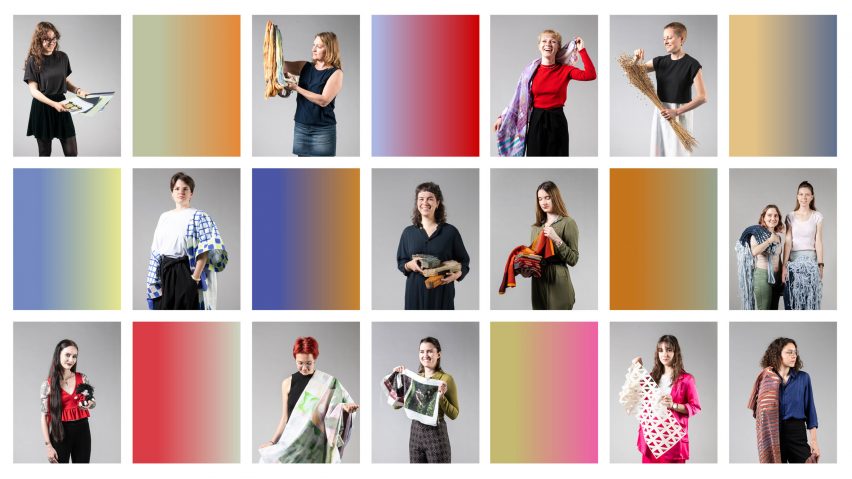
13 textile design projects from the Lucerne School of Art and Design
Dezeen school shows: a zero-waste cutting pattern and 21st-century neck ruffs feature in Dezeen's latest school show by textile design students from the Lucerne School of Art and Design.
Also included are an intelligent photovoltaic facade system and dance costumes designed to encourage and enhance different movements.
Lucerne School of Art and Design
University: Lucerne University of Applied Sciences and Arts
School: School of Art and Design
Course: BA Textile Design
Tutors: Marion Becella, Franziska Born, Brigitt Egloff, Lilia Glanzmann, Doris Kurzmeyer, Christa Michel, Daniela Zimmermann, Jonas Leysieffer, Caecilia Anderhub and Clara Sollberger
School statement:
"Our world is changing and textile designers are ideally equipped to face the challenges. Our work is transdisciplinary. We think in networks, respond to the new and stimulate transformations.
"Whether it's an intelligent photovoltaic facade, a resource-saving carpet or a dazzling outfit, textile design has innumerable facets. With a feeling for colour and pattern, functionality and sensuality, we constantly reinvent the universe of fibres, fabrics and surfaces anew.
"We join materials with designs and merge disciplines. Using this hybrid know-how, we develop forward-looking ideas and aesthetic objects for fashion, architecture, theatre, product design, the fine arts, interior architecture and research – always with the aim of actively applying craft approaches to a transforming world and meshing manual skills with the digital. Because we are grass-root experts, reconfiguring things where it has real effects."
Find out more about these and 250 other graduate projects from the Lucerne School of Art and Design at the university's virtual graduate show.
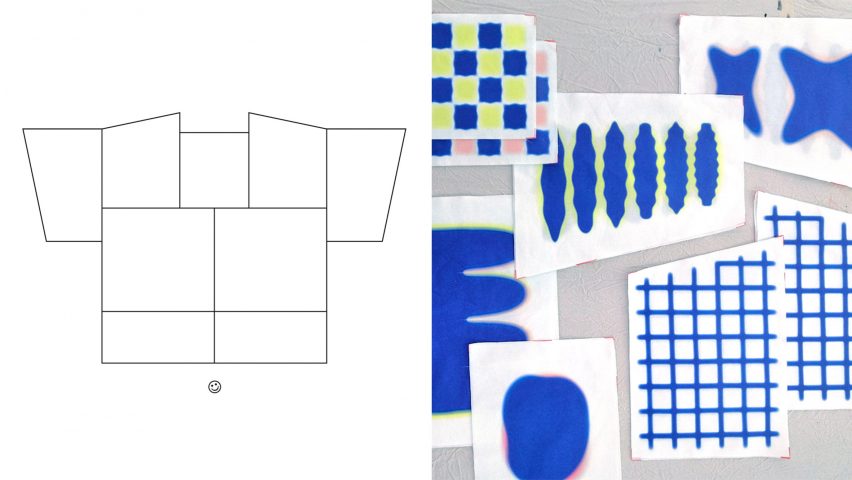
T×a×n×g×r×a×m by Renate Zeller
"Almost half of the fibres in the textile industry are discarded as waste. And even hand-sewing results in a lot of material being thrown away. Historical cutting patterns often consisted of straight-cut panels and squares in order to be economical.
"These formed the starting point for my work T×a×n×g×r×a×m – a zero-waste cutting pattern consisting of 18 geometrical pattern pieces that form a rectangle and function like the puzzle game that gives the project its name.
"By combing the various pattern pieces, various items of clothing and accessories can be laid out, cut out and produced without scraps."
Student: Renate Zeller
Tutors: Christa Michel, Caecilia Anderhub
Email: buero.pulp[at]gmail.com
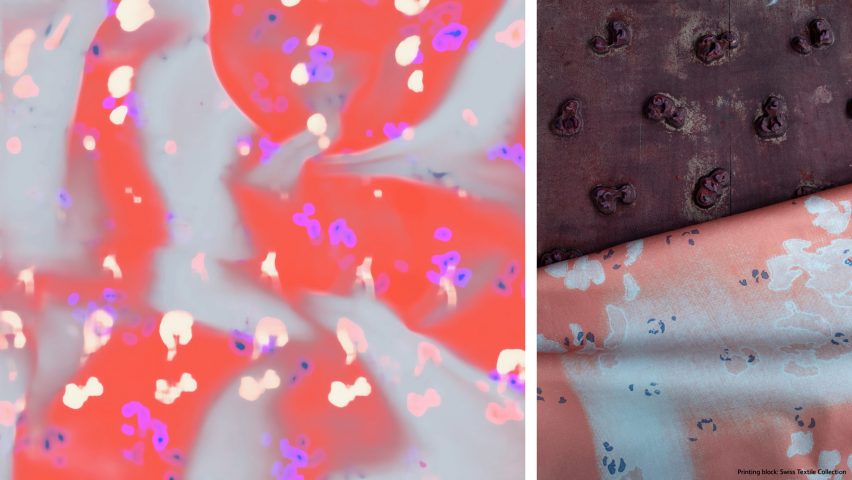
Sur Real by Marianne Simmen
"Textile collections hide a rich and varied inventory of patterns from bygone eras. Oftern for design analysis, they are difficult to access. Printing blocks from the Glarius region – Swiss Textile Collection – was used for this work.
"The blocks were used as a model to test the potential of historical collections for contemporary design processes. The focus lies in an experimental approach to analogue printing techniques and their further digital processing.
"This crossover between analogue and digital forms the basis for a collection of ideas."
Student: Marianne Simmen
Tutors: Marion Becella and Jonas Leysieffer
Email: marianne.simmen[at]gmail.com
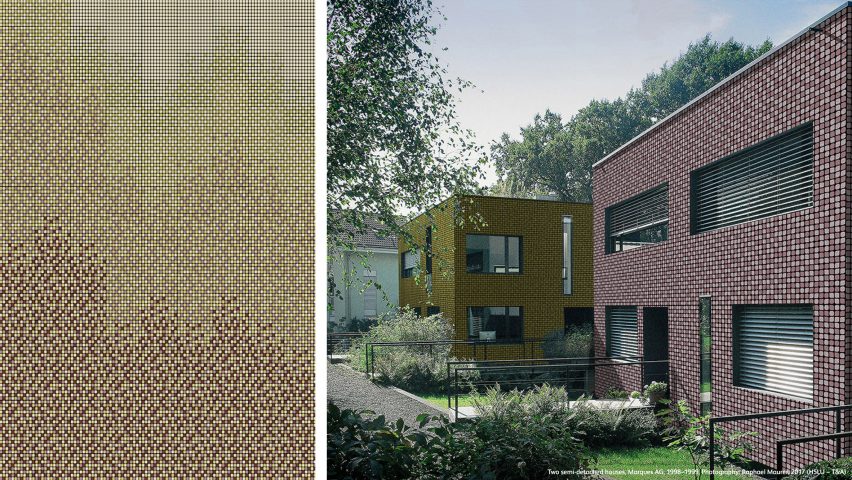
(In)visible by Florence Schöb
"Generating energy using photovoltaic technology is becoming ever more important in urban areas. In the form of a kit system, my work provides a design basis for the aesthetic deployment of photovoltaics on facades.
"Due to various combinations of the individual elements, a range of different facade designs are created. The designs consciously play with the solar panel's close-up and far-away appearance, generating shifting colour impressions from various distances.
"The work is part of a project by the Products and Textiles Research Group of the Lucerne School of Art and Design."
Student: Florence Schöb
Tutors: Franziska Born and Jonas Leysieffer
Email: florenceschoeb[at]bluewin.ch
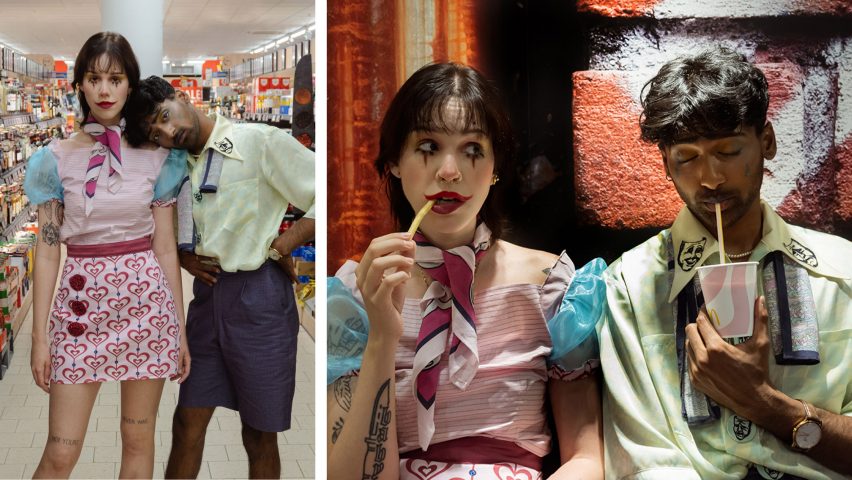
Clowning Around by Irina Nobs
"The clown is a fascinating figure that has existed for centuries. As a character, it appears again and again in films and on television. In this fictional film about my life, the two clowns Fiona and Robin navigate their journey together.
"The twins complement each other like day and night, making somewhat too much of a show of themselves in drab Swiss society.
"As a textile designer, I combine patterns and textures precisely. Using inkjet on cloth and embroidery by hand, the spirit of exaggeration – the clown-like – is applied to the costumes."
Student: Irina Nobs
Tutors: Daniela Zimmermann and Jonas Leysieffer
Email: irina.nobs[at]gmail.com
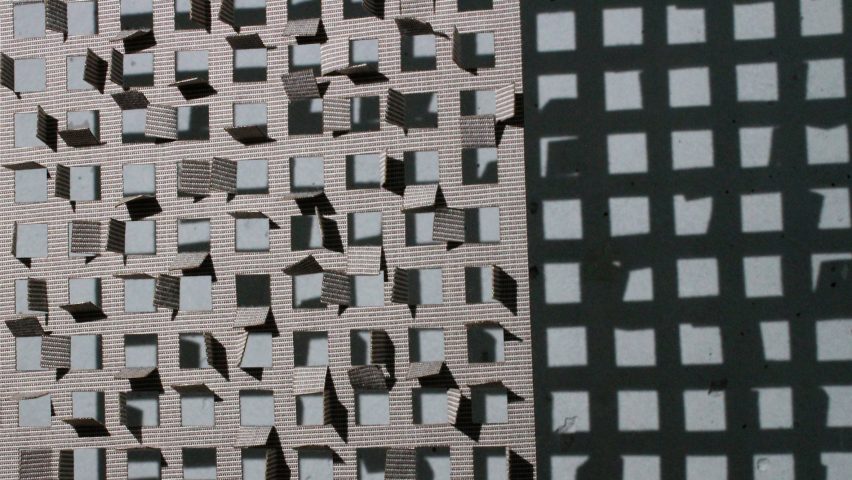
Manifatture Minimale by Gaia Leonardi
"The opportunity to collect the waste produced by manufacturers and transform it into new products is a reality in today's design disciplines. In cooperation with the Ticino-based manufacturer Rogica, I was able to acquire textile waste from their sun-blind manufacturing.
"By experimenting with various textile techniques, I tried to exploit the versatile quality of textiles by applying them to interior architecture products. The project reinforces the sustainability, the value and the essence of the concept 'less is more' in manual production."
Student: Gaia Leonardi
Tutors: Daniela Zimmermann and Caecilia Anderhub
Email: gaia.leonardi[at]bluewin.ch
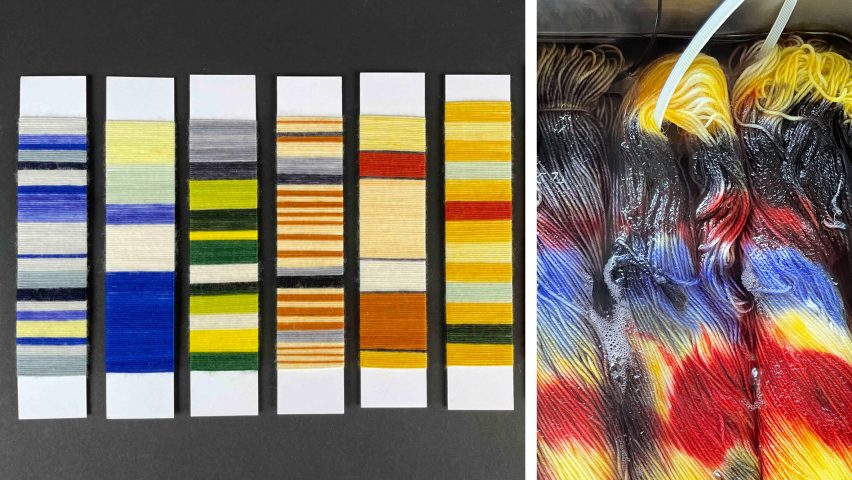
Road to Colour by Simone Kuhn
"What routes do associations of colour take before appearing on fabric? How can literature be implemented as an inspiration for colour?
"These questions are pursued in my work called Road to Colour. The basis for my design are commentaries and photographs by Swiss writer Annemarie Schwarzenbach, who travelled through Asia between the two world wars.
"Selected photographs and text passages are interpreted and composed into a colour story. Hand-dyed multi-colour and single-coloured yarns complement each other in small groups, thus forming chapters in this story. The colours are used in a collection of high-quality hand-knitted yarns."
Student: Simone Kuhn
Tutors: Marion Becella and Jonas Leysieffer
Email: info[at]fraukuhn.ch
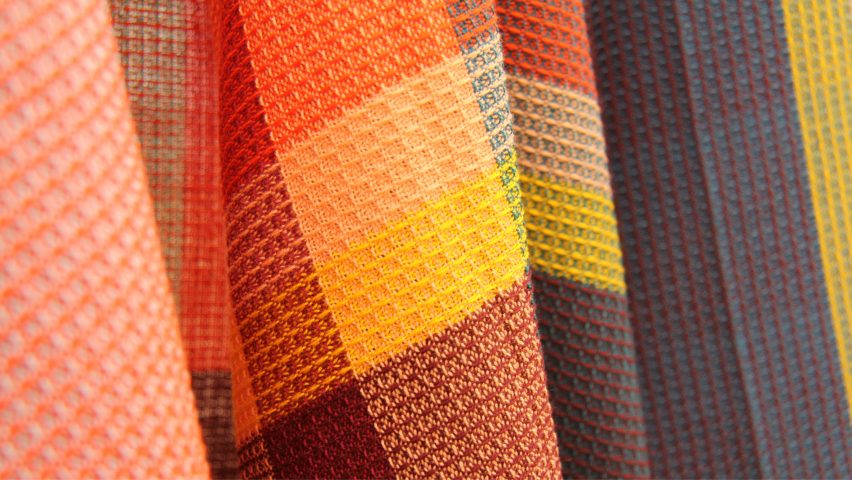
Dreaming Tea Towels by Jasmina Diggelmann
"In cooperation with people with disabilities, I developed a hand-woven collection of tea towels and dish cloths at the Bürgerspital Basel. The starting point was the idea of a dream place, which each participant defined for themself and gave a design expression.
"The ideas and textiles were created both in workshops and individual collaborations. The project seeks to utilise the potential of the participative processes in adapted workshops and to offer everyone in them the scope to realise their design abilities."
Student: Jasmina Diggelmann
Tutors: Marion Becella and Jonas Leysieffer
Email: jdiggelmann[at]ebmnet.ch
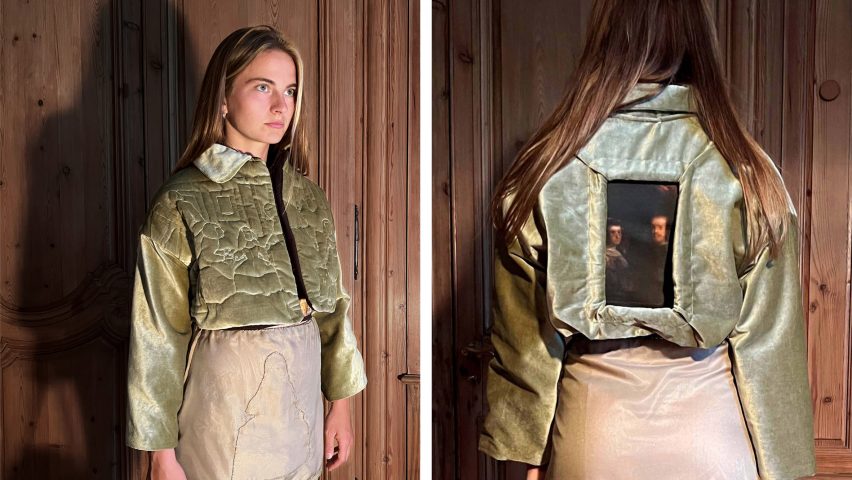
The Art of Referencing by Inês Dos Santos Bordonhos
"What distinguishes a painting as a whole? The way we perceive paintings is a very individual experience. However, the stories they depict have been analysed innumerable times. In my work, I wanted to understand more about the contents that inspire me as a textile designer.
"I combined my interests and decided to design three outfits, each of them derived from a separate picture. All three are classic Renaissance or Baroque paintings that have fascinated me due to their complex compositions.
"The focus of the work lies in the textile translation of these paintings."
Student: Inês Dos Santos Bordonhos
Tutors: Christa Michel and Jonas Leysieffer
Email: ines.bordo[at]hotmail.com
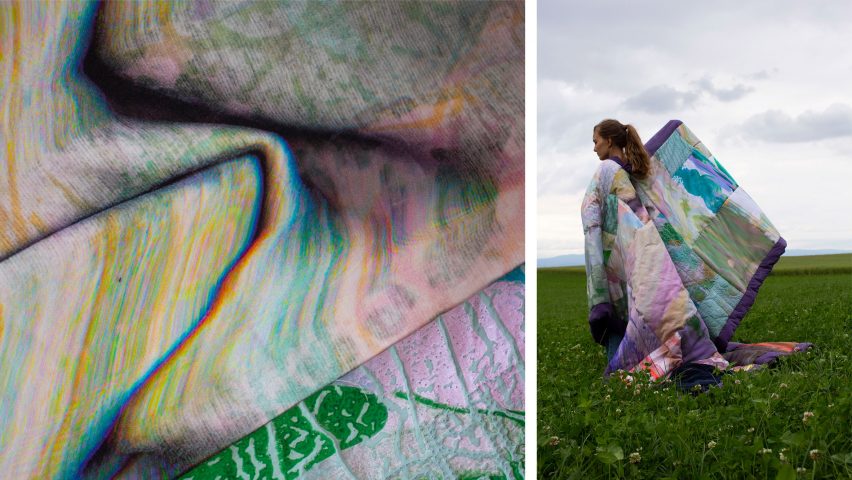
Nomadhome by Ida Buch
"Home. What exactly is it? Today as we move house more, experience multiple nodes of belonging or try to practice a locally anchored lifestyle, it is no longer that easy to feel properly at home.
"These prints emerged after interviews with various people, offering a visual interpretation of their associations with being at home.
"These interpretations of the smell, taste and sound of home are combined into a patchwork. The resulting textile envelopes us with the impressions and symbolises the feeling of being at home, detached from the surroundings."
Student: Ida Buch
Tutors: Franziska Born and Jonas Leysieffer
Email: ida.buch[at]gmx.de
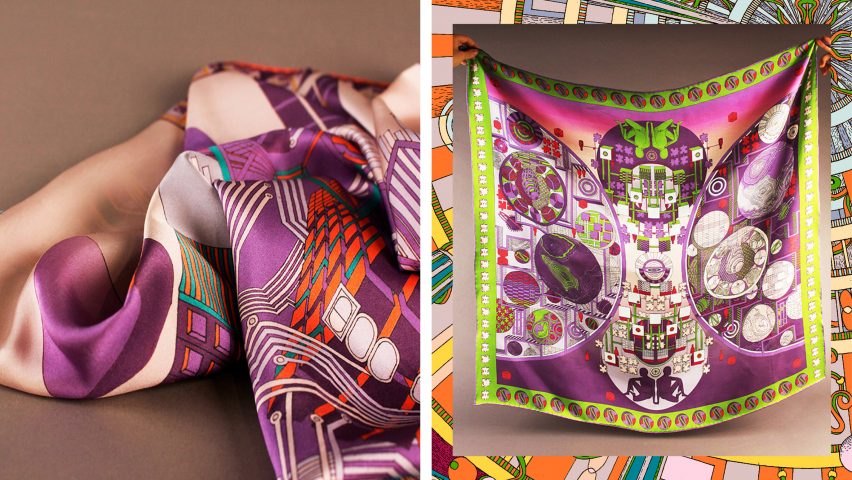
The Day After the Day After Tomorrow by Lina Brunekreeft
"The future can be scary but also a place of dreams. It is a surreal space that we can populate with individual visions. The basis for my foulards are interviews I conducted with five people on the subject of their personal as well as the global future.
"The answers were translated associatively into motifs and patterns. The colours, composition and motifs of each of the five foulards mirror the individual notions of the future of the interviewees, thus lending shape to an emotional issue."
Student: Lina Brunekreeft
Tutors: Daniela Zimmermann and Jonas Leysieffer
Email: lina.brun[at]bluewin.ch
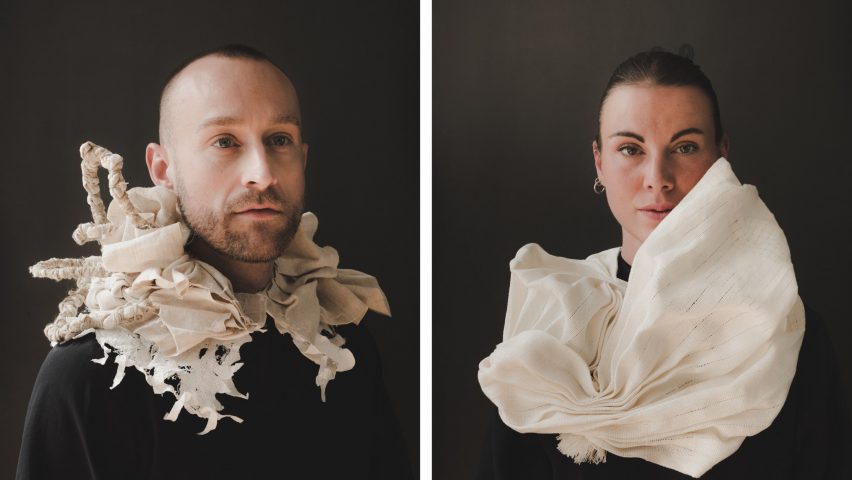
Clothed in collars by Olivia Brentini
"As a decorative textile accessory, the collar supplements clothing represents the wearer and gives them an individual appearance. This neck ornament has shaped people's outward look since the 16th-century and has had a particular influence on personal selfenactment.
"This work interprets this decorative item anew. The design of the collection focuses on the conscious and experimental handling of linen as a natural and local material. All the designs were either woven with Swiss flax or fashioned using discarded linen textiles."
Student: Olivia Brentini
Tutors: Franziska Born and Jonas Leysieffer
Email: olivia_brentini[at]gmx.ch
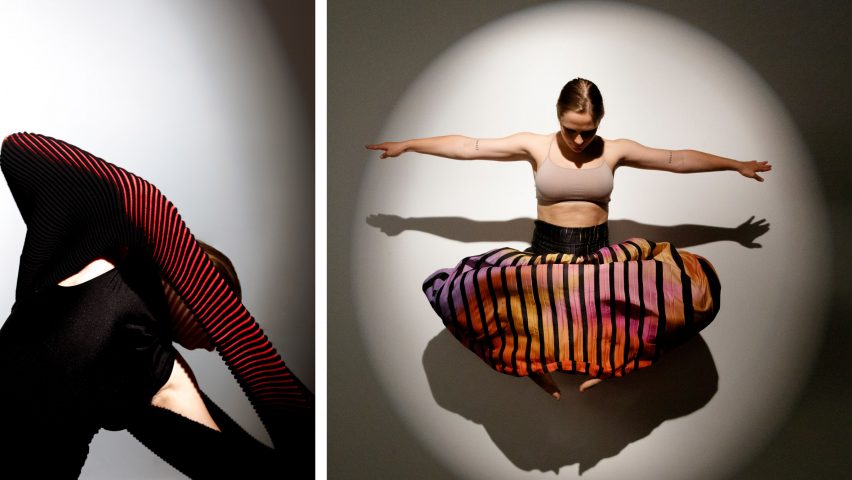
Flowing Fluid Costumes by Nina Baumann
"When a person begins to move, their clothes move with them. In dance, these movements are more experimental and the textiles react more intensely to the body. Based on this phenomenon, costumes were created that animate their wearers to motion.
"The textile designs are inspired by various dance moves. The costumes that finally result jointly shape the choreography of the dance and stimulate new sequences of movement. Dancing puts the textile in the spotlight, and a mutual correlation between the two art forms emerges."
Student: Nina Baumann
Tutors: Franziska Born and Jonas Leysieffer
Email: baumannnina4[at]gmail.com
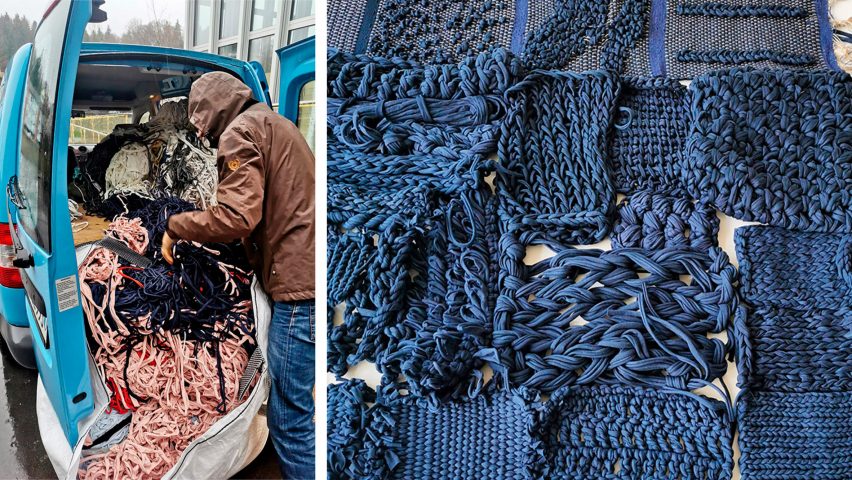
Devour by Laurène Affolter and Dagmar Blum
"The work deals with the utilisation of post-industrial textile waste using the example of a Swiss company. In this particular case, the firm produces 160 tonnes of residual textiles, of which 50 tonnes are thin edge cuttings from lengths of fabric.
"Due to their surface composition, the edge cuttings roll up into long, tubular strands known in the factory as spaghetti. Because this spaghetti is tangled and too thick to be machine-processed, we give the stands a surface and form by hand in combination with other textiles.
"There is a pressing need to reintroduce this unused material back into a circular system in a way that is easy and doesn't require further raw material inputs. The design focus of this process lies in the look and feel while the use stays open for refinement and inspiration."
Students: Laurène Affolter and Dagmar Blum
Tutors: Marion Becella, Daniela Zimmermann, Jonas Leysieffer and Caecilia Anderhub
Emails: laurene.affolter[at]gmail.com and dagmarblum0[at]gmail.com
Partnership content
This school show is a partnership between Dezeen and the Lucerne School of Art and Design. Find out more about Dezeen partnership content here.